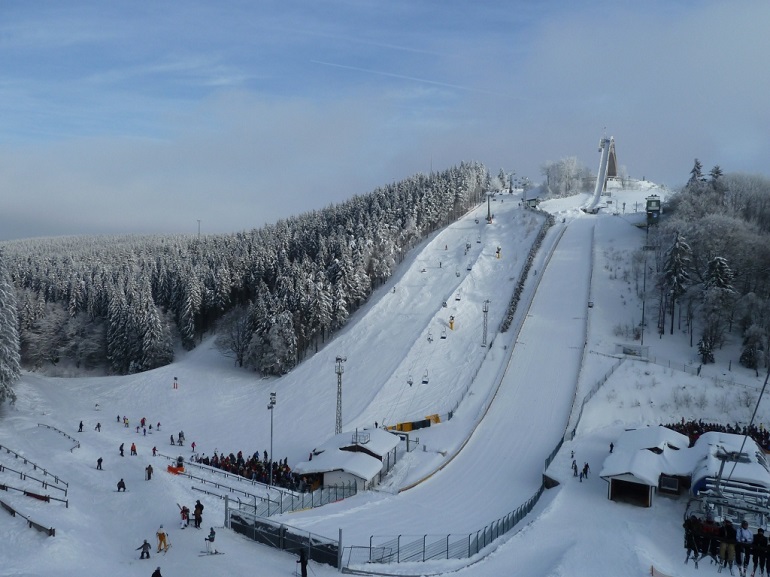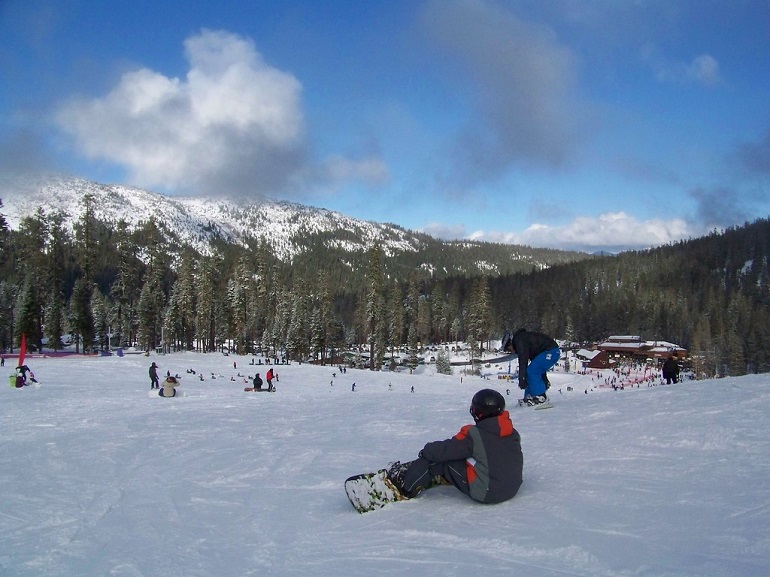Winter is coming, so the ski slopes are ready for some action. You should be aware of the best ski slope for your skill level before carrying your equipment up the hill.
Because I picked a slope that wasn’t appropriate for my level of competence at the time, my first trip down the hill wasn’t all that fantastic.
Ski slopes are graded in a variety of ways, and understanding those grades can help you customize your skiing experience.
Sometimes ski slope levels are different from one winter park resort to another. To understand why these ski slope levels are so important, you need to think a bit about how ski slopes are made.
Good ski areas should be steep enough to give people the most exciting ride possible but not so steep that they can’t control their speed. It should also vary in difficulty as it winds down, with sections that are easy for beginner skiers but more challenging for experts.
This is why there are many different ability levels of skiing slopes around the world – each one catering to skiers at different skill levels.
Let’s talk a bit about different ski slope levels and why these are important for you, a true ripper or a beginner in the game, on your next visit to a ski resort.
How Do Ski Resorts Determine How Difficult A Ski Slope Is?
There are three levels of difficulty in the ski world: beginner, intermediate and advanced.
These labels are determined by a number of factors, including terrain and ski trail width, and the ski resorts determine for themselves which slope is difficult and which one is easy, but there are also some standards.
Beginner slopes are often steeper than 45 degrees but less than 35 degrees; they usually have wider turns because most people who ski them aren’t very experienced yet. Intermediate runs are considered those with slopes between 35-45 degrees (with some exceptions).

Advanced runs have slopes between 30-50 degrees; these tend to be more narrow and technical than the intermediate terrain nearby, so they’re often reserved for folks who’ve been on skis for a while or want something more challenging than an intermediate run offers.
Getting the hang of skiing can be a lot of fun, but it’s also a steep learning curve. You’ll have to pick up new skills quickly if you want to avoid being left in the dust.
As a beginner skier, it’s important that you start off on the right foot by choosing an appropriate slope level.
The lower slopes are designed for beginners, while higher levels cater more toward advanced skiers and snowboarders who want steeper paths and faster speeds.
Skiers Should Know About the Following Difficulty Ratings
The slope rating system of a ski run indicates its difficulty level. To be more clear, the ratings are broken down into color codes.
The color coding makes it easy for skiers who aren’t familiar with the different ratings to make informed decisions about which slopes they want to tackle during their next visit to the mountain.
The ski slopes are often divided into blue, red, and black, however, occasionally there are differences, for instance from Europe to North America.
Blue Slopes – Easy
If you’re a beginner or intermediate skier, then blue trails are for you, literally being the color code for intermediate slopes. This is the easiest slope rating to ski on, and it’s also the most common.
If you want to stay away from the crowds, try heading over to a blue run on your next trip.
A blue run is probably the easiest of all slopes because there are less steep than red or black runs, which means they require less physical strength and balance as well as skill level.
This also means that if it’s your first time skiing or snowboarding ever, it’s highly likely that you will be able to handle yourself on this kind of trail without any problems at all!
Red Slopes – Intermediate
Red slopes are for skiers who want to challenge themselves without going all-out on advanced runs.
If you’ve got a few seasons under your belt, or if you feel like you’ve mastered the basics of skiing, red slopes will provide an intermediate challenge while still offering the thrill of skiing—without the riskier aspects associated with advanced terrain.
In other words, if you consider yourself one of the intermediate skiers out there, the red runs are for you.
Black Slopes – Expert

Black slopes are for advanced skiers only. They are steep slopes and the snow is very soft, so it’s easy to slide off of them. You will often see black slopes covered in ice or other things like rocks that can hurt you if you fall over them.
If you don’t have the training or skill level to be on ski trails coded as black slopes, don’t try!
North American Slope Levels
As I’ve mentioned before, slope levels are a way of measuring the steepness of a slope. Normally, in North America, they are measured using a scale from 1 to 5, with 5 being the most severe.
The severity rating for a slope is determined by its angle, length and height. Slopes with angles greater than 25 degrees are considered steep, while slopes with angles less than 15 degrees are considered flat.
To make things easier to understand, the North American slopes are also using a color code.
Green Circle
As a beginner, you’ll want to start at the green circle. Green circles are typically found on the beginner’s side of a resort and offer gentle slopes with wide, flat turns. They are ideal for beginner skiers because they have gentle slopes that don’t require much speed or turning ability.
Green runs are the easiest slopes on your mountain and are usually reserved for beginners or children. You will also see them as bunny hills though they may also be included in an intermediate area of the resort.
If you want to try skiing for the first time, then the green runs are for you. When you feel like your skiing ability is improved, then you can change the trail difficulty and go to the blue runs.
Blue Square
A blue square is an intermediate (or easy) slope that is suitable for all levels of skier or snowboarder but offers more challenges than green circle runs do.
In fact, a blue square it’s not too difficult—but still challenging enough that it won’t bore those with a bit of experience under their belts!
These blue square runs allow beginners with limited experience plenty of room for error without causing any major damage if something goes wrong (or even makes things worse).
Black Diamond

The Black Diamond run is one of the most challenging runs in all of the ski slopes and is frequently found at high altitudes, as it often resides on peaks with steeper terrain. If you want to ski this kind of mountain, you will need to prepare yourself for a workout.
The difficulty level of this trail varies from one mountain to another, but all Black Diamond slopes have the same general theme: steep inclines and sharp turns that are covered with ice or snow.
Double Black Diamond
The Double Black Diamond is the most difficult slope rating and is only for experienced skiers. Double Black Diamonds are not recommended for beginners and not even for intermediate skiers.
Double Black Diamond slope is considered more dangerous than the rest because it is more difficult to manage your speed on this type of terrain.

European Slope Levels
European slope levels are another way of measuring the steepness of a slope. They are measured in degrees, with 0 being the flattest and 90 being the steepest. Like in the case of the North American slopes, to make things easier, these levels have color codes.
Blue
The Blue Slope Level is the most common in Europe, and it is also the easiest. It’s generally considered to be a good starting point for those who have never skied or snowboarded before.
Blue runs are usually located near beginner lifts, so you can get help if you need it.
Red
Red slopes are intermediate slopes for skiers with some experience. The average gradient range of a red ski run is between 25 and 40%. Red runs are usually slightly narrower than blue ones.
Black
Black slopes are the most difficult. They have a gradient of more than 40%, and as you already know, are only for experienced skiers. If you are a beginner, it is really not a good idea to go on a black slope.
Double or Triple Black Diamonds
There are several levels of black diamonds that designate how challenging they are. Double or triple black diamonds have a greater slope angle than single black diamonds (50% steeper).
In addition to being more difficult to navigate on these slopes, double and triple blacks also require more skill to avoid falling off of them—because their steepness makes it harder to stop yourself from sliding down them if you lose your balance or grip on your skis or snowboard.

Other Types Of Slope Designations
As you saw in this article, the most famous ski slopes are the blue ones. They are the easiest to ski and allow beginners to learn how to ski – also, if you meet a green run, you need to know that this kind of slope is mostly for kids or for people who never went skiing before.
The next level is red: these are difficult, but not too difficult. After that comes black, which is extremely difficult.
Besides these color-coded ski slopes, there are all kinds of names for ski slopes, depending on the skill level it requires, depending on the terrain and the slope’s inclination.
Thus, it is possible to meet other names as you search for the perfect place for this winter, like ski slopes called bunny slopes (for beginners), freeride areas (for expert skier) or terrain parks (with jumps).
To feel the flow, let me explain a bit better the slopes I’ve mentioned here:
Bunny Slopes

These are beginner’s tracks or easy runs where most people start off their skiing adventure.
They are usually not too steep or long; they do not require any advanced skills or special equipment like ski helmets and wrist guards. You can think of beginner runs as green slopes.
Freeride Areas
These are perfect places for expert skiers who want to try something new or more challenging than usual. If you want to go on some challenging slopes, then the freeride areas are for you.
Terrain Park
This is an area designed specifically for tricks and jumps. There are many types of terrain parks, but they usually have rails and boxes where skiers can do tricks over them or jump from them.
Also, because we are talking about different slopes it is difficult for me not to mention one in Austria. The slope that I am talking about is called “Harakiri”, and it is the hardest ski area in Tyrol – with a steepness of 78%.

Final Thoughts
Even if ski slope ratings seem complicated, they are a handy tool for skiers to use when planning their trip to a ski resort.
You must have to carry the best walkie-talkies for mountains with you while skiing on dangerous slopes. A walkie-talkie is an easy approach to reducing risks and getting ready for unforeseen emergency scenarios.
While there are other factors such as snow conditions and terrain that affect how difficult a run might be, knowing what kind of difficulty level you’re up against will help you determine whether or not it’s worth trying out in the first place!
It’s also important to remember that one person’s easy run is another person’s nightmare—so don’t let anyone tell you how hard something is unless they’ve actually skied it themselves at least once before.
0 Comments